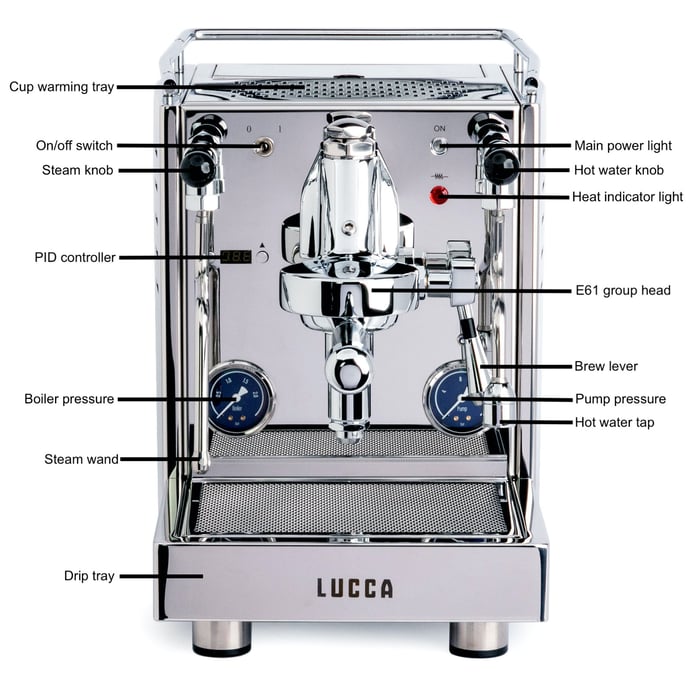LUCCA X58: User Manual
Set Up Your LUCCA X58 Espresso Machine. In this manual, you will find everything you need to operate and maintain your heat exchanger, E61 espresso machine.
Please make sure to read carefully before using your LUCCA X58 by Quick Mill. If you have any other questions, be sure to contact us.
Included Accessories:
- Double spouted portafilter
- Bottomless portafilter
- Single basket (7g)
- Double basket (18g)
- Triple basket (20g)
- Three and four-hole steam tip
- Backflush disc
- Wood-handled stainless steel tamper
Water
Espresso machines have specific water requirements. Two primary considerations are filtration and hardness.
Filtration removes tiny particles, such as sand or rust, in your water. If these particles were allowed to enter your machine, they could cause all manner of trouble, specifically by clogging the small valves and other parts in your espresso machine. Almost any water filter will do the job, whether it’s the one built into your fridge, a Brita, or a whole-house filter. Ensuring that this filter is replaced at the proper time will be essential to ensure machine health.
Water hardness is equally important. Ideally, we want a hardness of between 35-85 ppm (parts per million). Hardness refers to the dissolved solids or mineral content in your water. Common dissolved solids are things like magnesium, calcium, and various forms of sodium. These dissolved solids are what make water, and therefore espresso, taste good. But an excess will result in scale buildup inside your machine. Scale can cause irreparable damage to your machine by clogging and forming a mineralized layer over the surface of metal parts. The process of descaling is even more damaging, eating away at the machine’s metal internals. Luckily, scale can be entirely avoided by keeping your water hardness within the recommended TDS range of 35-85 ppm.
There are numerous methods to soften your water if the mineral content has been tested to be too high for your machine.
- A Note on RO (Reverse Osmosis) or Distilled Water
Taste aside, espresso machines require some mineral content to function properly. Their steam boiler fill probes, in particular, use the conductivity of water to detect the water level. With no dissolved solids, they’ll overfill, giving you water instead of steam. You must add some mineral content back in. Our recommendation is Third Wave Water packets, which are designed to offer ideal flavor and be safe for your machine.
- Reservoir Solutions
Our first recommendation is a simple in-tank water softening pouch. They’re affordable, last 4-6 months, and are very effective. Using RO water purchased by the gallon in combination with Third Wave Water packets is another great option.
No matter what solution you pick, we recommend testing the water coming from your machine’s group head every few months. City water hardness changes seasonally, and softening systems wear out. Quarterly testing will ensure you keep your machine safe.
First Time Setup with Reservoir
- Place the machine on an even and stable surface.
- Fill your water reservoir with your filtered and softened water, leaving a few inches at the top to prevent spillage. Ensure that you do not spill water on top of the machine when filling, as this may cause electrical damage.
- Plug in the machine and turn on the power switch.
- The pump will begin filling the boiler of the machine with fresh water. As soon as the boiler is filled, the pump sound will stop. A large amount of water is required for the first filling of the boiler. You can expect to refresh the water tank with water during this startup process. You will want to refill the reservoir with your filtered and softened water at this point.
- Wait until the boiler pressure gauge indicates approx—1.0-1.25 bar.
PID Adjustment
To change your boiler temperature, press both the up and down buttons at the same time to access the PID settings. Press the up button to edit the programmed boiler temperature, then and press up or down to your desired temperature. Don't press anything for three seconds to return to the settings menu, and press the down button until you reach the original temperature display.
Technical Details
For a complete list of technical details, please see the spec table on our product page.
Now you're ready to start pulling shots! Check out our Espresso 101 section to learn about steaming milk, latte art, our suggested starter espresso recipe, grinder dial-in tips, and much more!
Looking for Help with Flow Control?
Helpful Links
Still have questions? Reach out to our coffee experts and technicians.
